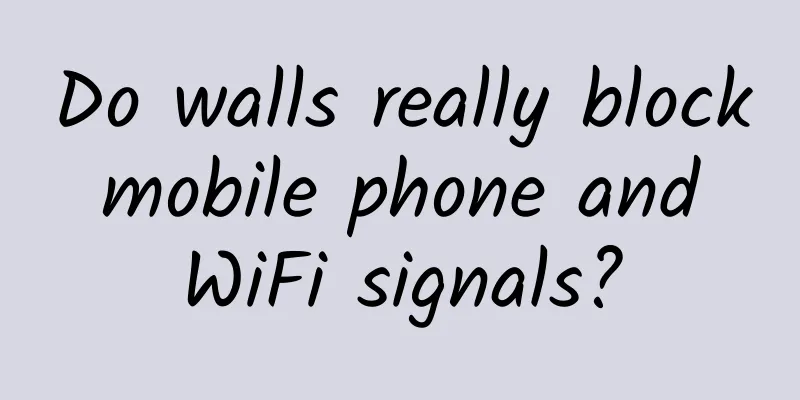Do walls really block mobile phone and WiFi signals?

|
If you are always holding your mobile phone, you will definitely find that when you enter a basement or some high-rise buildings, the mobile phone signal often attenuates significantly; when you enter an elevator, there is generally no signal at all. Seeing this, I believe everyone has recalled similar experiences. Our intuitive cognition tells us that the signal seems to be lost when passing through the wall, which seems to be related to the thickness of the wall. This is probably why the signal is not good in the basement or in some buildings. This "theory" can also barely explain why there is no signal in the elevator. However, when I tell you that wrapping the phone with a thin layer of tin foil can completely block the signal, this phenomenon seems to be inexplicable with our intuitive cognition of "thick walls blocking signals" theory.I believe everyone knows that the propagation of mobile phone signals is carried out by electromagnetic waves that change at a certain frequency. Near the mobile phone, the larger the amplitude of the electromagnetic waves carrying the signal, the better the mobile phone signal. If we come to a place with a weak signal, it means that only a small part of the electromagnetic wave signal can reach here. Life experience tells us that the amplitude of electromagnetic waves will indeed decrease after passing through walls, causing signal attenuation. But what exactly hinders or even blocks the propagation of electromagnetic waves, causing the mobile phone to lose signal? To solve this problem, we have to start with a physical phenomenon. The propagation of electromagnetic waves in a medium follows the "skin effect". As the name suggests, it is the phenomenon that electromagnetic waves tend to the surface. Looking up the definition, we know that when there is alternating current or alternating electromagnetic field in a conductor, the current distribution inside the conductor is uneven, and the current is concentrated in the "skin" part of the conductor, that is, the current is concentrated in the thin layer on the surface of the conductor. The closer to the surface of the conductor, the greater the current density, and the current inside the wire is actually smaller. As a result, the resistance of the conductor increases, and its power loss also increases. This phenomenon is called the skin effect. So what does this effect have to do with the propagation of mobile phone signals? It turns out that when electromagnetic waves carrying signals pass through some media, they are restricted by the skin effect, causing part of the electromagnetic waves to remain on the surface of the medium and unable to completely pass through the medium. The better the conductivity of the medium, the more obvious the blocking effect on electromagnetic waves. Now let's assume there is a wall that the electromagnetic wave wants to pass through. If the wall is completely insulating, then in the eyes of the electromagnetic wave, there is no such wall at all, and it can pass through it happily without any loss; but if the wall is conductive, for example, the wall is made of metal, in the eyes of the electromagnetic wave, this is an insurmountable high wall, and it is almost impossible to pass through it. This is why a thin layer of tin foil can make the mobile phone lose signal, and it is for this reason that the signal is particularly poor in c (the elevator is equivalent to a metal box). So far, we know that materials with strong conductive properties (metals or various materials that can conduct electricity) will have a serious impact on the propagation of electromagnetic waves. At this time, someone may ask, aren’t the walls of buildings non-conductive? Then why do they also hinder the propagation of electromagnetic waves and attenuate mobile phone signals? As mentioned before, if this is a "pure" wall, electromagnetic waves will pass through it with almost no loss. But we know that in order to enhance the load-bearing capacity of the wall, reinforced concrete structures are widely used in the construction industry. That is to say, the wall contains not only insulating materials such as cement, but also conductive steel bars, and of course various wires buried in the wall. This makes the wall have a certain blocking effect on electromagnetic waves. Therefore, when we are in the underground space, the signal will be weakened to varying degrees until it disappears completely. Examples of skin effect hindering signals are widely found in various fields. As we know, seawater is a good conductor of electricity. In the military, in order to transmit simple signals such as "up", "down", "forward", "stop" and so on to submarines underwater, large antenna arrays must be used to emit high-intensity electromagnetic wave signals. However, even so, communication can only be achieved at a maximum of about 30 meters underwater. Once this distance is exceeded, communication becomes extremely difficult. However, everything has its two sides. The skin effect does bring us a lot of inconvenience, but it also has some beneficial applications. For example, the skin effect can be used to create an electrostatic shielding area (similar to a Faraday cage) and perform some precise experimental measurements. Someone will definitely ask again, is there no way to eliminate or avoid this effect so that the signal can be transmitted smoothly? Because this is the basic property of electromagnetic waves, it is indeed difficult to eliminate it, but we have many ways to avoid the occurrence of this effect. For example, many elevators are equipped with a small signal repeater to fill the elevator with signals; similarly, many subway stations have installed some signal repeaters along the line, so that you can play with your mobile phone unimpeded even more than ten meters underground. Physics tells us that there are physical principles behind various phenomena in life. Physicists summarize simple but profound laws of physics through various phenomena. As a winner of Toutiao's Qingyun Plan and Baijiahao's Bai+ Plan, the 2019 Baidu Digital Author of the Year, the Baijiahao's Most Popular Author in the Technology Field, the 2019 Sogou Technology and Culture Author, and the 2021 Baijiahao Quarterly Influential Creator, he has won many awards, including the 2013 Sohu Best Industry Media Person, the 2015 China New Media Entrepreneurship Competition Beijing Third Place, the 2015 Guangmang Experience Award, the 2015 China New Media Entrepreneurship Competition Finals Third Place, and the 2018 Baidu Dynamic Annual Powerful Celebrity. |
<<: Starting from 209,800 yuan, Xpeng P7+ starts pre-sale at Paris Motor Show
>>: Apple responds to slow progress in iPhone 6s battery replacement: We don't have that much stock
Recommend
Confession of Wugong Mountain: What kind of geological changes have I experienced when I was born 800 million years ago?
Speaking of Wugong Mountain, we may know that it ...
Traffic is so expensive, but conversion rate is so low?
Traffic is so expensive and conversion is so low!...
From an operational perspective, here are 4 tips to crack sales tactics
Behind every strongest salesperson is a set of lo...
How to lower user expectations and achieve sustained product growth?
Killing users’ unnecessary expectations and overl...
It is called "soft gold in water" and China now produces it the largest amount in the world!
The golden and slightly charred skin, the soft an...
China Association of Automobile Manufacturers: The added value of automobile manufacturing industry grew rapidly from January to September 2022
According to data from the National Bureau of Sta...
What should we pay attention to when developing the Guiyang Mall mini program? What are the things to pay attention to when developing a shopping mall mini program?
What should we pay attention to when developing t...
Suing Samsung and US operators: Why does Huawei frequently engage in patent wars?
Not long ago, Huawei filed intellectual property ...
How to write an activity plan? Here are 3 great tips!
At work, we often encounter such problems: The co...
How to do marketing on Women’s Day? Here are 4 tips for you!
Today is International Women's Day... NO, you...
After trying out the mini-app, I found that Android users finally crushed Apple fans
In order to reflect Zhang Xiaolong's understa...
These teachers have extraordinary identities!
Newton once said: " If I have seen further t...
Popular Science | "Centennial Sugarcane" - The Legend of the Chinese Species of Sugarcane
[ Introduction ] Sugarcane is the fifth largest c...
The "golden time" for breakfast and dinner is out! Eat before this time to stay away from many diseases!
"Is it best to finish breakfast before 9 o&#...
Private Domain Traffic Operation and Construction Strategy
If we compare private domain traffic to a fish po...









